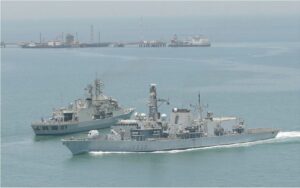The Red Sea warship decision: a continuation of the continental drift in our strategy

Last year I wrote the maritime opinion piece on the Defence Strategic Review (DSR) for the WA Defence Review 2022–23 annual issue. In it I opined that there were some promising signs, but I also stated that the danger for the maritime realm lay in the details.
I noted in my article that: ‘The strategy of denial, which permeates this document, is worrying. The crux of the issue for Navy is that it is too small, both in workforce and power projection capability to achieve sea control at distance.’ While it is true that the acquisition of conventionally armed nuclear-powered submarines will transform Navy’s capability, I also stated that: ‘As a report that purports to protect Australia’s economic connection to the world and defend Australia and our immediate region, the air and surface warfare maritime aspects of it are disappointing.’
This concern has been reinforced by the recent Red Sea decision. The clamour in the media about RAN ships being vulnerable to drones, and comparisons to the land and littoral seas focused Ukraine–Russia war and successful attacks on archaic Russian vessels, have been exasperating in their predictability in this country. There is also apparent obliviousness for some that sea lanes of communications, essentially trade routes, on which Australia’s economy is so dependent, actually run the whole way from start points to their final destination. Disruption at any point on them is possible.
In defence of the Albanese Government’s decision, the Coalition Government’s strategy that preceded the DSR was similarly imperfect. It also framed an Indo-Pacific region that stopped in an imaginary line south of India. The problem for Australia and for the protection of our trade links to Europe, the Middle East and Africa is that the Indian Ocean doesn’t magically end south of India. Our trade can be affected in the Suez Canal, in the Red Sea, in the Persian Gulf, the Strait of Hormuz, the Gulf of Oman and so on.
The notion that we only need to project at the most about 1000kms from Australia to protect ourselves has grown only stronger in Defence, government, academic and media circles since the Dibb Report of 1986, with its emphasis on defending Australia and our immediate approaches. Having mentioned that report, Professor Paul Dibb importantly has also been critical of the Albanese Government’s decision, stating that the policy never excluded sending modest forces further afield to support global security.
However, Australia’s inexorable drift to a continental strategy has been a continuum in official Australian military thinking since the 1980s. Today in reality, Australia has a veneer of a maritime strategy, absent any true power projection or persistence across the large blue bits on the map that surround us, while our defence spending is just adequate to have a strategy of denial to the approaches to our land itself. As I also stated in my maritime opinion piece, ‘that the DSR even mentioned the discredited concept of Tier 2 combatants, and doubled down on the 1980s idea of unmitigated reliance on northern bases of air support, air control, denial and deterrence is worrying.’
In 2003 I coined the phrase ‘girt by beach’ to describe Australians and our concept of the maritime. To most Australians the maritime extends merely as far as they can see from the beach as they relax over summer, or it is something they fly over to get to a holiday destination or cruise on. That in 2024 we now also believe that an ‘immediate region’ can be computed on its western end by an artificial line drawn in the middle of the Indian Ocean half way along numerous key shipping trade routes is a dangerous misconception that will not end well for Australia, nor those who serve their country and will need to prosecute operations persistently at distance in the maritime should the worst happen.
I do not know if it the decision not to send a ship was based on primarily domestic political concerns or a belief in Defence and government circles that the Middle East is not still a substantial issue for Australia. Obviously, we have to focus on the complexity of China, but this does not absolve us from sending modest forces further afield, as Professor Dibb noted. I do know, however, that our Navy, even with its limited power projection capabilities and personnel challenges could have risen to the task, as it has done almost continuously in that region since 1990. Indeed, the operational experience would enhance our forces.
Our ships with their state of the art Australian and US radars, combat systems and weapons and crewed by excellent young professional Australians, dedicated to their country and their Navy, are more than capable with US and other allies of dealing decisively with whatever threats the Houthis and others in the region may pose. For some to imply otherwise, shows further inexperience with the maritime and our Navy.
